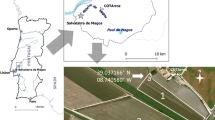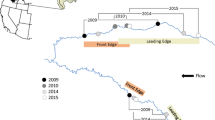Abstract
Invasive crayfish have severely impacted invaded aquatic ecosystems worldwide. We studied temporal and spatial variation in the range expansion of the red swamp crayfish at one of the first European localities to which it was introduced: Doñana National Park (SW Spain). In contrast to the rapid range expansion witnessed in other areas, this invasive crayfish has not spread across the entire park. Instead, its distribution has expanded during wet periods, but contracted during drought periods. The red swamp crayfish has caused steep amphibian declines in other invaded areas. However, after approximately 35 years of crayfish presence in Doñana National Park, we have yet to detect a reduction in the number or occurrence of amphibian species. Amphibians may thus be protected by the large abundance of temporary ponds in the area, which provides them with an effective refuge network. We show that natural fluctuations in annual rainfall and in the number of ponds filled can temporarily eliminate invasive crayfish from particular areas. This fact should be taken into account when attempting to reduce the impact of crayfish on aquatic communities, intensifying crayfish removal during particularly dry years, when it is most effective.




Similar content being viewed by others

References
Bernardo, J. M., A. M. Costa, S. Bruxelas & A. Teixeira, 2011. Dispersal and coexistence of two non-native crayfish species (Pacifastacus leniusculus and Procambarus clarkii) in NE Portugal over a 10-year period. Knowledge and Management of Aquatic Ecosystems 401: 28.
Blaustein, A. R., B. A. Han, R. A. Relyea, P. T. J. Johnson, J. C. Buck, S. S. Gervasi & L. B. Kats, 2011. The complexity of amphibian population declines: understanding the role of cofactors in driving amphibian losses. Annals of the New York Academy of Sciences 1223: 108–119.
Bravo, M. A., C. M. Duarte & C. Montes, 1994. Environmental factors controlling the life history of Procamburus clarkii (Decapoda, Cambaridae) in a temporary marsh of the Doñana National Park (SW Spain). Verhandlungen des Internationalen Verein Limnologie 25: 2353–2450.
Brooks, R. T., 2004. Weather-related effects on woodland vernal pool hydrology and hydroperiod. Wetlands 24: 104–111.
Burnham, K. P. & D. R. Anderson, 2002. Model selection and multimodel inference: a practical information-theoretic approach. Springer, New York.
Cano, E. & M. E. Ocete, 2000. Tamaño medio y ecología reproductiva de Procambarus clarkii Girard (1852) (Decapoda, Cambaridae) en las marismas del bajo Guadalquivir. Zoología Baetica 11: 17–26.
Correia, A. M. & O. Ferreira, 1995. Burrowing behavior of the introduced red swamp crayfish Procambarus clarkii (Decapoda: Cambaridae) in Portugal. Journal of Crustacean Biology 15: 248–257.
Cruz, M. J. & R. Rebelo, 2005. Vulnerability of Southwest Iberian amphibians to an introduced crayfish, Procambarus clarkii. Amphibia-Reptilia 26: 293–303.
Cruz, M. J. & R. Rebelo, 2007. Colonization of freshwater habitats by an introduced crayfish, Procambarus clarkii, in Southwest Iberian Peninsula. Hydrobiologia 575: 191–201.
Cruz, M. J., R. Rebelo & E. G. Crespo, 2006. Effects of an introduced crayfish, Procambarus clarkii, on the distribution of south western Iberian amphibians in their breeding habitats. Ecography 29: 329–338.
Cruz, M. J., P. Segurado, M. Sousa & R. Rebelo, 2008. Collapse of the amphibian community of the Paul do Boquilobo Natural Reserve (central Portugal) after the arrival of the exotic American crayfish Procambarus clarkii. Herpetological Journal 18: 197–204.
Díaz-Paniagua, C., 1988. Temporal segregation in larval amphibian communities in temporary ponds at a locality in SW Spain. Amphibia-Reptilia 9: 15–26.
Díaz-Paniagua, C., C. Gómez-Rodríguez, A. Portheault & W. de Vries, 2005. Los anfibios de Doñana. Serie Técnica. Ministerio Medio Ambiente-OAPN, Madrid.
Díaz-Paniagua, C., C. Gómez-Rodríguez, A. Portheault & W. de Vries, 2006. Distribución de los anfibios del Parque Nacional de Doñana en función de la densidad y abundancia de los hábitats de reproducción. Revista Española de Herpetología 20: 17–30.
Díaz-Paniagua, C., R. Fernández-Zamudio, M. Florencio, P. García-Murillo, C. Gómez-Rodríguez, A. Portheault, L. Serrano & P. Siljeström, 2010. Temporary ponds from the Doñana National Park: a system of natural habitats for the preservation of aquatic flora and fauna. Limnetica 29: 41–58.
Fahd, K., M. Florencio, C. Keller & L. Serrano, 2007. The effect of the sampling scale on zooplankton community assessment and its implications for the conservation of temporary ponds in south-west Spain. Aquatic Conservation: Marine Freshwater Ecosystems 17: 175–193.
Ficetola, G. F., M. E. Siesa, R. Manenti, L. Bottoni, F. De Bernardi & E. Padoa-Schippa, 2011. Early assessment of the impact of alien species: differential consequences of an invasive crayfish on adult and larval amphibians. Diversity Distribution 17: 1141–1151.
Florencio, M., C. Díaz-Paniagua, I. Gomez-Mestre & L. Serrano, 2011. Sampling macroinvertebrates in a temporary pond: comparing the suitability of two techniques to detect richness, spatial segregation and diel activity. Hydrobiologia 689: 121–130.
Florencio, M., C. Díaz-Paniagua, C. Gómez-Rodriguez & L. Serrano, 2013. Biodiversity patterns in a macroinvertebrate community of a temporary pond network. Insect Conservation and Diversity. doi:10.1111/icad.12029.
Fortuna, M., C. Gómez-Rodríguez & J. Bascompte, 2006. Spatial network structure and amphibian persistence in stochastic environments. Proceedings of the Royal Society London B: Biological Sciences 273: 1429–1434.
Geiger, W., P. Alcorlo, A. Baltanás & C. Montes, 2005. Impact of an introduced crustacean on the trophic webs of Mediterranean Wetlands. Biological Invasions 7: 49–73.
Gherardi, F., 2007. Understanding the impact of invasive crayfish. In Gherardi, F. (ed.), Biological invaders in inland waters: profiles, distribution, and threats. Invading Nature Springer series in invasion ecology. Springer, Dordrecht: 507–542.
Gherardi, F., L. Aquiloni, J. Diéguez-Uribeondo & E. Tricarico, 2011. Managing invasive crayfish: is there a hope? Aquatic Sciences 73: 185–200.
Gomez-Mestre, I. & C. Díaz-Paniagua, 2011. Invasive predatory crayfish do not trigger inducible defences in tadpoles. Proceedings of the Royal Society B 278: 3364–3370.
Gómez-Rodríguez, C., J. Bustamante & C. Díaz-Paniagua, 2010a. Evidence of hydroperiod shortening in a preserved system of temporary ponds. Remote Sensing 2: 1439–1462.
Gómez-Rodríguez, C., C. Díaz-Paniagua, J. Bustamante, A. Portheault & M. Florencio, 2010b. Inter-annual variability in amphibian assemblages: implications for diversity assessment and conservation in temporary ponds. Aquatic Conservation: Marine Freshwater Ecosystems 20: 668–677.
Gómez-Rodríguez, C., C. Díaz-Paniagua & J. Bustamante, 2011. Cartografía de Lagunas temporales del Parque Nacional de Doñana. Agencia Andaluza del Agua, Consejería Medio Ambiente. Junta de Andalucía, Sevilla.
Habsburgo-Lorena, A. S., 1978. Present situation of exotic species of crayfish introduced into Spanish continental waters. Freshwater Crayfish 4: 175–184.
Holdich, D. M., J. D. Reynolds, C. Souty-Grosset & P. J. Sibley, 2010. A review of the ever increasing threat to European crayfish from non-indigenous crayfish species. Knowledge and Management of Aquatic Ecosystems 2009(394–395): 11.
Hoffmann, M., C. Hilton-Taylor, A. Angulo, et al., 2010. The impact of conservation on the status of the world’s vertebrates. Science 330: 1503–1509.
Kats, L. B. & R. P. Ferrer, 2003. Alien predators and amphibian declines: review of two decades of science and the transition to conservation. Diversity and Distributions 9: 99–110.
Kiesecker, J. M., 2003. Invasive species as a global problem: toward understanding the worldwide decline of amphibians. In Semlitsh, R. D. (ed.), Amphibian Conservation. Smithsonian Press, Washington, DC: 113–126.
Moyle, P. B. & T. Light, 1996. Biological invasions of freshwater: empirical rules and assembly theory. Biological Conservation 78: 149–161.
Peay, S., 2009. Invasive non-indigenous crayfish species in Europe: recommendations on managing them. Knowledge and Management of Aquatic Ecosystems 394–395(03): 1–9.
Portheault, A., 2010. Efecto de la depredación sobre las puestas y larvas de los anfibios de Doñana. Ph.D. thesis, Universidad de Sevilla, Spain.
Portheault, A., C. Díaz-Paniagua & C. Gómez-Rodríguez, 2007. Predation on Bufo calamita eggs and larvae by common predators in temporary ponds. Revue Ecologie-Terre Vie 62: 315–322.
Ricciardi, A. & H. J. MacIsaac, 2011. Impacts of biological Invasions on Freshwater Ecosystems. In Richardson, D. M. (ed.), Fifty Years of Invasion Ecology: The Legacy of Charles Elton. Blackwell Publishing, Oxford: 211–224.
Rodríguez, C. F., E. Bécares, M. Fernández-Aláez & C. Fernández-Aláez, 2005. Loss of diversity and degradation of wetlands as a result of introducing exotic crayfish. Biological Invasions 7: 75–85.
Semlitsch, R. D., 2003. Conservation of pond-breeding amphibians. In Semlitsh, R. D. (ed.), Amphibian Conservation. Smithsonian Press, Washington, DC: 8–23.
Siesa, M. E., R. Manenti, E. Padoa-Schioppa, F. De Bernardi & G. F. Ficetola, 2011. Spatial autocorrelation and the analysis of invasion processes from distribution data: a study with the crayfish Procambarus clarkii. Biological Invasions 13: 2147–2160.
Simberloff, D., 2005. Non-native species DO threaten the natural environment! Journal of Agricultural and Environmental Ethics 18: 595–607.
Siljeström, P., A. Moreno, L. V. García & L. E. Clemente, 1994. Doñana National Park (south-west Spain): geomorphological characterization through a soil-vegetation study. Journal of Arid Environment 26: 315–323.
Tablado, Z., J. L. Tella, J. A. Sánchez-Zapata & F. Hiraldo, 2010. The paradox of the long-term positive effects of a North American crayfish on a European community of predators. Conservation Biology 24: 1230–1238.
Valverde, J. A., 1967. Estructura de una Comunidad Mediterránea de Vertebrados Terrestres. Monografías de la Estación Biológica de Doñana, CSIC, Madrid.
Wells, K. D., 2007. The Ecology and Behavior of Amphibians. The University of Chicago Press, Chicago, London.
Acknowledgements
We thank the monitoring team of the Doñana Biological Reserve for providing the crayfish survey data and Isabel Afán (LAST-EBD) for her assistance with map figures. This study was funded by the Spanish Ministry of Economy and Competitiveness and EU Feder Funds (Project CGL2009-11123/BOS, CGL2012-) and by the Spanish Ministry of Agriculture, Food and Environment (Project 158/2010). CK was supported by grants from the Agencia Española de Cooperación Internacional—AECI (Spain), the Conselho Nacional de Desenvolvimento Científico e Tecnológico—CNPq, proc. nr. 204322-89 (Brazil) and the Fundación Caja Madrid (Spain) from 1991 to 1999. CGR is funded by the Xunta de Galicia (postdoctoral fellowship POS-A/2012/052).
Author information
Authors and Affiliations
Corresponding author
Additional information
Handling editor: Lee B. Kats
Rights and permissions
About this article
Cite this article
Díaz-Paniagua, C., Keller, C., Florencio, M. et al. Rainfall stochasticity controls the distribution of invasive crayfish and its impact on amphibian guilds in Mediterranean temporary waters. Hydrobiologia 728, 89–101 (2014). https://doi.org/10.1007/s10750-014-1808-6
Received:
Revised:
Accepted:
Published:
Issue Date:
DOI: https://doi.org/10.1007/s10750-014-1808-6



